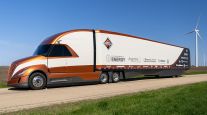Navistar Net Income Doubles in 2nd Quarter
This story appears in the June 14 print edition of Transport Topics.
Navistar International Corp. more than doubled its net income during the three months ended April 30, even though the company’s second fiscal-quarter revenue dipped, compared with the same time last year.
Navistar, the manufacturer of International trucks and MaxxForce engines, earned $30 million, or 42 cents a share, up from $12 million, or 16 cents a share, in the 2009 fiscal quarter. Sales over the same time declined 2.3% to $2.74 billion from $2.81 billion.
It was the Warrenville, Ill., corporation’s first full quarter that did not include the results from its medium-duty engine sales to Ford Motor Co., a formerly substantial business that ended Dec. 31.
Navistar also said its military products sales declined from the year-ago quarter, but sales of trucks, engines and parts in North and South America improved enough to keep revenue stable and profits accelerating.
The original equipment manufacturer affirmed its earnings guidance for the current fiscal year, which ends Oct. 31, at $2.75 to $3.25 a share.
“The second quarter for us was very significant. First of all, the results were good, in spite of some challenges out there in the economy,” Chairman and CEO Daniel Ustian said during the company’s June 9 conference call with stock analysts.
“You’ll see that our core business had significant improvements in it,” Ustian said. “At the same time, we made many investments. We had a significant number of launches going on that kind of prep us for what’s going to happen next.”
Each of the OEM’s three major manufacturing segments turned a profit for the quarter. The truck unit earned the most, with operating income of $76 million on sales of $1.85 billion.
The manufacturer’s parts division had the best profit margin, 14.5%, compared with 4.1% for trucks and 3.4% for engines. A decline in the sale of parts to the military was mitigated by increasing sales of North American commercial truck parts, the company said.
While the engine division’s margin was low, it did post a $15 million profit after losing $84 million in the same quarter last year. A year ago, the engine unit was burdened by costs associated with the closing of the Ford business. Most of the profits this quarter came from the $12 million recovery of value-added taxes in Brazil.
Ustian also expressed confidence in his company’s engine choice to meet 2010 federal emissions regulations. Navistar is the only OEM using exhaust gas recirculation for medium- and heavy-duty diesel engines. All other North American truck and engine makers are using selective catalytic reduction.
The issue is of great importance, Ustian said, because Navistar now relies entirely upon its in-house engines to power its trucks. It no longer buys engines from Cummins Inc. or Caterpillar Inc.
He cited a survey by Quixote Research Group, which he said showed that 31.2% of potential customers said they were very likely to purchase a truck with an EGR engine, 51.2% were very likely to buy an SCR-powered truck and 17.6% were undecided. That survey means Navistar is the only choice for the EGR group and the company has a shot at some of the undecided business.
“By this study, it says we’re going to be successful at a 30% share,” he said.
Another point Ustian stressed in his discussion of heavy-duty marketing was 13-liter engines. While the company still plans to bring a 15-liter engine to market, it is concentrating for now on the 13-liter model.
Citing deals announced earlier this year, Ustian said intermodal and truckload carrier J.B. Hunt Transport Services, Lowell, Ark., will use some 13-liter engines rather than 15-liters. Heartland Express will also convert to 13 liters from 15 liters, Ustian said.
Flatbed carrier Boyd Bros. Transportation Inc., Clayton, Ala., is also using 13-liter models.
“For 2010, we will be able to match or exceed with a 13-liter engine, and we’ve tested this ourselves and we’ve had customers test this against the performance of a 15-liter,” Ustian said, adding that he estimates a 13-liter engine weighs about 500 pounds less than a 15-liter model.




